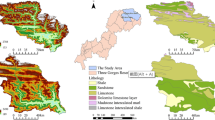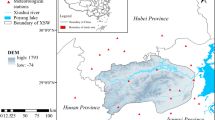Abstract
The relationship between soil erosion distribution and its influencing factors is critical for soil erosion modeling and soil conservation planning. Based on subbasins, this study quantitatively analyzed the variation of relationships between spatial pattern of soil erosion risk and its main influencing factors such as slope, rainfall, vegetation cover, and land use in Yimeng mountainous area from 1986 to 2005. The results showed that, on the hilly and mountainous region, the increase of vegetation cover and optimized land use structure resulted in an evident decline of erosion risk over the period of approximately 20 years, especially in the second half of the period. The number of subbasins with soil erosion risk index value over 2 decreased from 49 in 1995 to 29 in 2005 due to the Grain for Green Program implemented in this area. As the increase of spatial heterogeneity of rainfall erosivity in 2005, rainfall with a low contribution rate (about 5.4%) became one of the significant factors affecting the spatial pattern of erosion risk. With the impact of human activities on the erosion, the contribution rate (CR) of slope on the erosion pattern fell from 92.8 to 79.7%. The CR of vegetation cover diminished from 7.2% in 1986, while that of land use structure gradually enhanced to 14.9% in 2005. This study indicated that with the restoration of vegetation cover; the impact of land use pattern on soil erosion distribution had become increasingly important, suggesting that more attention should be paid to the role of adjustment and optimization of land use structure in soil erosion control in this area.









Similar content being viewed by others
References
Baigorria GA, Romero CC (2007) Assessment of erosion hotspots in a watershed: integrating the WEPP model and GIS in a case study in the Peruvian Andes. Environ Modell Softw 22:1175–1183
Bathurst JC, O’Connell PE (1992) Future of distributed modeling: the Systeme Hydrologique Europeen. Hydrol Process 6(3):265–277
Bou Kheir R, Abdallah C, Khawlie M (2008) Assessing soil erosion in Mediterranean karst landscapes of Lebanon using remote sensing and GIS. Eng Geol 99:239–254
Cebecauer T, Hofierka J (2008) The consequences of land-cover changes on soil erosion distribution in Slovakia. Geomorphology 98:187–198
Elwell HA, Stocking MA (1976) Vegetal cover to estimate soil erosion hazard in Rhodesia. Geoderma 15:61–70
Fullen MA, Booth CA, Brandsma RT (2005) Long-term effects of grass ley set-aside on erosion rates and soil organic matter on sandy soils in east Shropshire, UK. Soil Tillage Res 89:122–128
Guo ZS (2000) Effective, critical and potential coverage of vegetation community for soil and water conservation. Bull Soil Water Conserv 20(2):60–62 (in Chinese with English abstract)
Gutman G, Ignatov A (1998) The derivation of the green vegetation fraction from NOAA/AVHRR data for use in numerical weather prediction models. Int J Remote Sens 19:1533–1543
Jensen JR (1996) Introductory digital image processing: a remote sensing perspective. Prentice Hall, New Jersey
Kefi M, Yoshino K, Setiawan Y, Zayani K, Boufaroua M (2010) Assessment of the effects of vegetation on soil erosion risk by water: a case of study of the Batta watershed in Tunisia. Environ Earth Sci. doi:10.1007/s12665-010-0891-x
Krishna Bahadur KC (2009) Mapping soil erosion susceptibility using remote sensing and GIS: a case of the Upper Nam Wa Watershed, Nan Province, Thailand. Environ Geol 57(3):695–705
Le Bissonnais Y, Benkhadra H, Chaplot V, Fox D, King D, Daroussin J (1998) Crusting, runoff and sheet erosion on silty loamy soils at various scales and upscaling from m2 to small catchments. Soil Tillage Res 46:69–80
Li XX, Li TH, Ni JR (2008) Analysis on spatial scaling effects of water erosion in the Yellow River basin. Prog Geogr 27(6):49–56 (in Chinese with English abstract)
Liang RJ (2003) An analysis of regulation countermeasurse for reforesting formerly cultivated land in mountain areas: with mountain area of Yimeng as an example. Sci Technol Manag Land Resour 5:139–142 (in Chinese)
Lu D, Li G, Valladares GS, Batistella M (2004) Mapping soil erosion risk in Rondonia, Brazilian Amazonia: using RUSLE, remote sensing and GIS. Land Degrad Dev 15:499–512
Ma L, Zuo CQ, Sun M, Li HM (2010) Spatial characteristics and simplified empirical models of annual rainfall erosivity in Shandong Province. Res Soil Water Conserv 17(2):28–31 (in Chinese with English abstract)
Men MX, Zhao TK, Peng ZP, Yu ZR (2004) Study on the soil erodibility based on the soil particle-size distribution in Hebei Province. Sci Agric Sin 37(11):1647–1653 (in Chinese with English abstract)
Ministry of Water Resources of PR China (1997) Criterion of classification of soil erosion. China Water Power Press, Beijing (in Chinese)
Ni JR, Li YK (2003) Approach to soil erosion assessment in terms of land-use structure changes. J Soil Water Conserv 58(3):158–169
Ni JR, Li XX, Borthwick AGL (2008) Soil erosion assessment based on minimum polygons in the Yellow River basin, China. Geomorphology 93:233–252
Poesen JWA, Hooke JM (1997) Erosion, flooding and channel management in Mediterranean environments of southern Europe. Prog Phys Geogr 21:157–199
Satty TL (1980) The analytic hierarchy process. McGraw-Hill, New York
Schiettecatte W, D′hondt L, Cornelis WM, Acosta ML, Leal Z, Lauwers N, Almoza Y, Alonso GR, Díaz J, Ruíz M, Gabriels D (2008) Influence of land use on soil erosion risk in the Cuyaguateje watershed (Cuba). Catena 74:1–12
Seyfried MS, Wilcox BP (1995) Scale and the nature of spatial variability: field examples having implications for hydrologic modeling. Water Resour Res 31(1):173–184
Sun XM, Sun XH, Feng JH (2007) Sensitivity appraisal for soil erosion in the Yimeng mountainous area. Bull Soil Water Conserv 27(3):84–88 (in Chinese with English abstract)
Sun XH, Zhang DM, Yao XY, Yan FJ (2008) Research on different vegetation landscape and soil erosion in Yimeng mountain areas. Res Soil Water Conserv 15(6):6–9 (in Chinese with English abstract)
Tan BX, Li ZY, Wang YH (2005) Estimation of vegetation coverage and analysis of soil erosion using remote sensing data for Guishuihe drainage basin. Remote Sens Technol Appl 20(2):215–220 (in Chinese with English abstract)
Tian GJ, Zhang ZX, Zhao XL, Zhang GP, Tan WB (2002) The soil erosion distribution characteristics and ecological background of Chinese cultivated land. Acta Ecol Sin 22(1):10–16 (in Chinese with English abstract)
Tian YC, Zhou YM, Wu BF, Zhou WF (2009) Risk assessment of water soil erosion in upper basin of Miyun Reservoir, Beijing, China. Environ Geol 57(4):937–942
Turkelboom F, Poesen J, Trébuil G (2008) The multiple land degradation effects caused by land-use intensification in tropical steeplands: a catchment study from northern Thailand. Catena 75:102–116
Ugur Ozcan A, Erpul Gunay, Basaran Mustafa, Emrah Erdogan H (2008) Use of USLE/GIS technology integrated with geostatistics to assess soil erosion risk in different land uses of Indagi Mountain Pass—Cankırı, Turkey. Environ Geol 53(8):1731–1741
Van Rompaey A, Govers G (2002) Data quality and model complexity for regional scale soil erosion prediction. Int J Geogr Inf Sci 16:663–680
Verstraeten G (2006) Regional scale modelling of hillslope sediment delivery with SRTM elevation data. Geomorphology 81:128–140
Vrieling A (2006) Satellite remote sensing for water erosion assessment: a review. Catena 65:2–18
Vrieling A, Sterk G, Vigiak O (2006) Spatial evaluation of soil erosion risk in the West Usambara Mountains, Tanzania. Land Degrad Dev 17:301–319
Vrieling A, De Jong SM, Sterk G, Rodrigues SC (2008) Timing of erosion and satellite data: a multi-resolution approach to soil erosion risk mapping. Int J Appl Earth Obs Geoinf 10:267–281
Xie HX, Li R, Yang QK, Li J, Liang W (2009) Effect of returning farmland to forest (pasture) and changes of precipitation on soil erosion in the Yanhe basin. Sci Agric Sin 42(2):569–576 (in Chinese with English abstract)
Xu YQ, Peng J, Shao XM (2009) Assessment of soil erosion using RUSLE and GIS: a case study of the Maotiao River watershed, Guizhou Province, China. Environ Geol 56(8):1643–1652
Yan P, Xu SL (1994) Shandong soil. China Agriculture Press, Beijing (in Chinese)
Zhao QG (2002) Spatial and temporal variation. Mechanism and control of soil degeneration at red soil area in South China. Science Press, Beijing (in Chinese)
Zheng FL (2006) Effect of vegetation changes on soil erosion on the Loess plateau. Pedosphere 16(4):427–460
Zhou P, Luukkanen O, Tokola T, Nieminen J (2008) Effect of vegetation cover on soil erosion in a mountainous watershed. Catena 75:319–325
Acknowledgments
This work was financially supported by the Program for New Century Excellent Talents in University from Ministry of Education of China (Grant No. NCET-08-0877), a Grant from the Foundation for Study Encouragement to Middle-aged and Young Scientist of Shandong Province, China (Grant No. 2007BS08025), and the Natural Science Foundation of Shandong Province, China (Grant No. Y2008E23). The authors thank the anonymous reviewers for their insightful comments that greatly improved the paper.
Author information
Authors and Affiliations
Corresponding author
Rights and permissions
About this article
Cite this article
Ma, Q., Yu, X., Lü, G. et al. The changing relationship between spatial pattern of soil erosion risk and its influencing factors in Yimeng mountainous area, China 1986–2005. Environ Earth Sci 66, 1535–1546 (2012). https://doi.org/10.1007/s12665-011-1393-1
Received:
Accepted:
Published:
Issue Date:
DOI: https://doi.org/10.1007/s12665-011-1393-1




